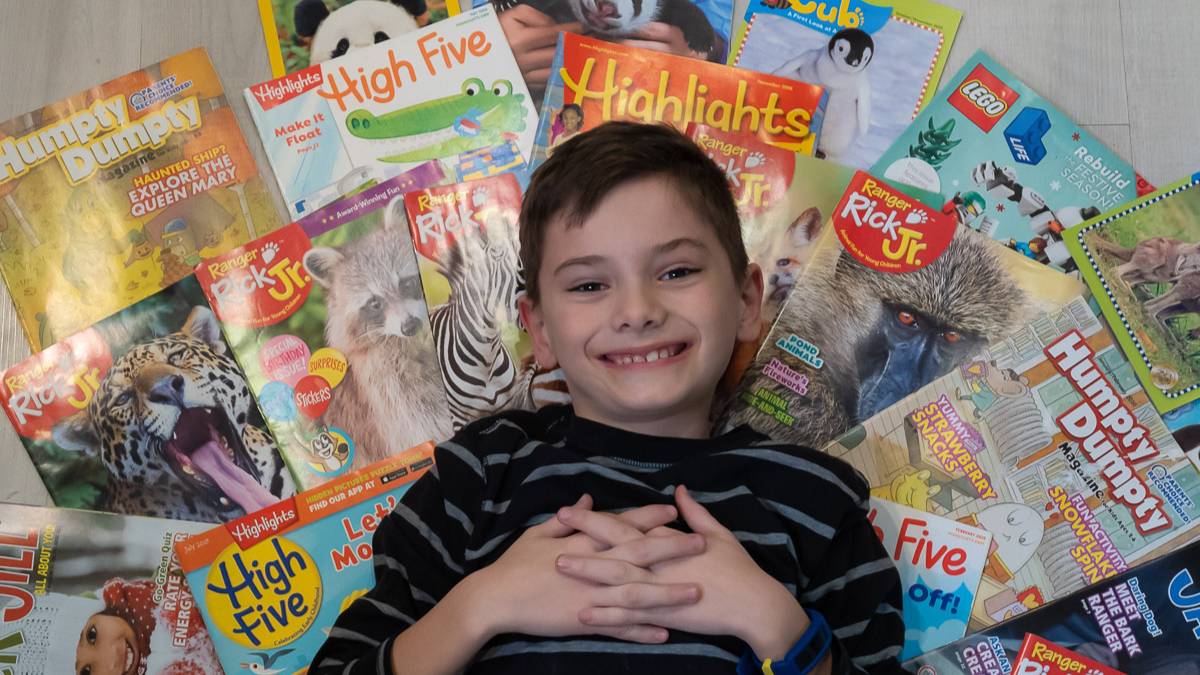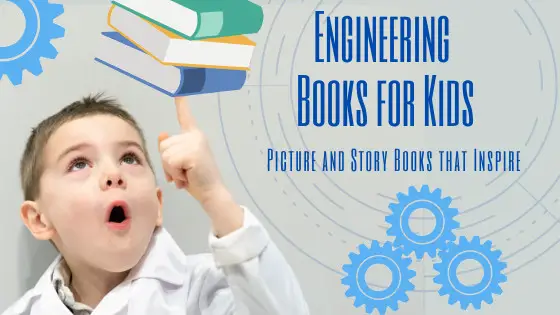In this post we’ll share our favorite engineering books for kids. These are largely picture books that are easy to read, and show how imagination and creativity can lead to great designs. Engineering can be fun. Let’s explore!
The Boy Who Harnessed the Wind
by William Kamkwamba and Bryan Mealer

I first came across William Kamkwamba’s in his TED Talk and was inspired; and also a bit humbled. His resourcefulness and situation put my own daily struggles in perspective. A 14 year old boy building a windmill out of spare parts and junk to save his starving village seems like it should be a storybook. This one happens to be true.
Watch William’s TED Talk; it’s only 5 minutes long, and sets the stage for his accomplishments.
A severe drought had crippled the farming community where William grew up. Crops withered along with hope. His family ate only one small meal a day, and William had to drop out of school.
Starting with nothing more than a dream and hunger (both figuratively and literally) William devoured science books in the local library. But it wasn’t as easy as simply picking up a book. William did not speak or read much English, and had to use dictionaries to translate. Even so, he learned how machines worked and came across information on a windmill. He learned that windmills can produce electricity and pump water; two things his village was lacking.
He decided to build a windmill. But how? He would have to use whatever was available.
As William began picking trash from the local junkyard, his neighbors thought he was crazy. As he put pieces together and the windmill started to take shape, some people started to help. When the wind finally turned the blades and lit up a light bulb William had connected to the windmill, he proudly proclaimed, “I have made electric wind!”
What an incredible feat of engineering! Also William’s determination, grit, and ingenuity serve as a role model for kids and adults alike.
You can also see William’s first ever Ted Talk here. He had never been away from home, and spoke a little bit of English. The difference in his command of language and his stage presence is remarkable in the two year span between these talks.
What Do You Do With An Idea?
by Kobi Yamada
Illustrated by Mae Besom

Sometimes the most brilliant things are so simple. This is a powerful book, yet so innocent and disarming. One day an idea pops up in a young boy’s life, as ideas tend to do. The idea is in the form of a golden egg with a crown.
At first, the boy denies the idea and walks away (as we often do with new ideas.) The idea followed him. And the more he got used to the idea, it started to grow on him. Still, he kept it hidden. I shudder to think how many ideas are lost because we are too lazy to act, or too afraid others may not like our ideas.
As the boy paid more attention to the idea, the egg grew bigger. Eventually, he began to show the idea to others. Sure, some thought it was silly or just didn’t like it. He even wavered a bit with doubt and second thoughts. Uncertainty aside, by this point the boy was committed to his idea and didn’t seem to care. The egg was his friend. He protected it. He loved it.
The idea began to change how the boy viewed the world. He started to see things a bit differently than everyone else. One day, suddenly, the idea “went from being here to being everywhere.” It wasn’t just part of the boy anymore, but part of everything.
The use of color in this book is striking. While nurturing the egg, there is a limited color pallet. The idea itself is a golden egg, while the only other colors are drab greens and browns. Toward the end of the book when the idea takes off, the pages explode with bright colors. Again, simple but powerful.
Ideas are something that happen to all of us, so it’s easy to relate to the young child in the story. We have all felt this way. We all have lost or neglected ideas. We often resist them at first, though some ideas have a bit more tenacity and demand our attention. That’s how ideas grow.
Everything begins as a thought, an idea. Everything. What starts as the smallest idea can change the world. Read this book to your children to illustrate the importance of nurturing and protecting their ideas. Read it to yourself for exactly the same reasons.
What Do You Do With An Idea? Is a winner of the Independent Publisher Book Award, and a New York Times bestseller.
Iggy Peck, Architect
by Andrea Beaty

Iggy Peck had a passion for building and architecture from early on, using anything on hand to build what he dreamed. Dirty diapers, dirt clods, food, and sticks of chalk; he would use whatever was on hand to create. That is, until a teacher squashed his dreams.
Teachers are so influential in children’s early years. One offhand remark can wound so deeply as to squelch a child’s interest. On the other hand, teachers wield great power in the support and encouragement they can give a child.
While on a field trip, the class gets stranded on an island. The teacher fainted, and by the time she awoke, young Iggy had constructed a bridge and led the class to safety. He used his gift to save the day.
This book could be a great jumping off point for STEM challenges. What household items could you use to build a bridge? A skyscraper? What could you build with just cardboard boxes, or paper cups? Try using whatever is on hand, just like Iggy. Just be sure to empty the diaper bin before letting them loose.
Rosie Revere, Engineer
by Andrea Beaty

Aspiring engineer Rosie loved to invent, until a dear uncle laughed at her invention. Discouraged by the disapproval of a trusted adult, Rosie lost some of her enthusiasm. She still tinkered, but hid her talent away, until inspired to help her great aunt (Rosie the Riveter) check off her last bucket list wish and fly.
Rosie designs a flying machine for her aunt, and when it crash’s so does Rosie’s spirit. Her aunt delivers one of the best messages every scientist and engineer must learn. Failure is often only a lesson. It’s only truly failure if you quit.
Rosie went back to work with the “We can do it” attitude that made her great aunt famous.
This book embodied the idea of failing, adapting, and moving on so well, we took a look at Rosie Revere, Engineer in this post about learning from failure.
The Most Magnificent Thing
by Ashley Spires

As the girl in the story tries to build her “magnificent thing,” she reworks it. She tries different ideas, but they seem to fall short of the idea in her head. She works harder until she is frustrated and angry.
She takes a break, which provides some much needed clarity and perspective. When she returns to working, the ideas flow. She realizes her original ideas weren’t totally off the mark, and has more focus. Others find magnificent things in the parts she discards, and eventually she settles on her own magnificent thing.
This is a great study on the creative process. We all have our own ideas. They’re perfect in our heads, but lose something in execution. We may become frustrated with ourselves for not being able to perfectly give our ideas form. Sometimes walking away for a bit gives us the ability to see things more clearly (just be sure to come back. It’s all too easy to shelve an idea and leave it in a half-finished limbo.)
The Most Magnificent Thing shows kids that it’s okay to make mistakes, and it’s okay if your ideas don’t turn out perfect the first time around. We’re often our own worst critics. Perseverance (and sometimes taking a walk) allows us to take our things over the finish line and make them magnificent.
What is your most magnificent thing? Go ahead, take one of those dusty half finished ideas off of the shelf. Make it magnificent.
There’s an adorable adaptation of the Most Magnificent Thing on Amazon Prime.
If I Built a Car
by Chris Van Dusen

As Jack rides in the backseat, he shares with his father his thoughts on what a car should be. If Jack built a car, he’d take inspiration from rockets and planes, zeppelins and trains. The car looks like a space age Cadillac, with jets, fins, and a big dome. Jack’s car is made from a “polymer gel” that he invented so the car won’t get dented. It includes a couch, a pool, and an automated snack bar.
The seats spin around to reveal a robot that’ll take the wheel. Reading this sparked conversations about current innovations with self-driving cars.
Jack’s car can also act as a boat, submarine, and plane, and we get a glimpse of the adventures as Jack takes his father for a spin using each mode of transportation.
If I Built a Car reads with the same rhyming flow of Dr Seuss, and makes a great read along book for story time.
I love the opening thoughts Jack shares:
I’ll work through the night to create a design
Constantly analyze, tweak, and refine.
This simple couplet embodies the notion of design. It all starts with a simple idea, which is tweaked and refined through the process. And what a fantastical design Jack wound up with! Published in 2005, this book was way ahead of self-driving cars. Perhaps Google could adopt a few of the other features Jack imagines. (I still want my flying car!)
If I Built a Car is a winner of the E.B. White Read Aloud Award.
If I Built a House
by Chris Van Dusen

Another one by Chris Van Dusen. As Jack sits in his backyard, he imagines a dream house of his own design. Jack leads us (and his mother) on a tour through his house, complete with an anti-gravity flying room, a swim through aquarium, and a bedroom with quite a view. There’s an automated kitchen and bathroom, an art room, and more.
This is a great STEM read for its creative design. The whimsical ideas and construction can plant the seeds that it’s fun to dream big
We see Jack’s table strewn with classic building toys like Legos, Lincoln Logs, and Tinker Toys, as well as a model constructed from cardboard (and a frisbee roof.) Like so many young kids discover, these toys are the gateway to building grand designs. It was great to see them included in Jack’s world.
Monkey with a Tool Belt
by Chris Monroe

Got tool belt? Check! Follow the adventure of Chico Bon Bon as he builds and fixes all sorts of things. Like Batman, Chico seems to have the solution to every problem in his belt. That is, until he gets captured and taken to perform in a circus. Have no fear, Chico uses his ingenuity and tools to escape and return safely home.
This book has whimsical artwork and an easy to read style. It’s just silly enough to have some fun with your kids while reading aloud.
Author and Illustrator Chris Monroe has chronicled Chico Bon Bon’s engineering adventures in a series of books, each presenting a new challenge for the Money with a Tool Belt:
Monkey with a Tool Belt and the Seaside Shenanigans – in which Chico solves a mystery at a beach resort.
Monkey with a Tool Belt and the Maniac Muffins – where Chico uses his ingenuity (and tool belt) to save the town from a crazy batch of muffins.
Monkey with a Tool Belt and the Noisy Problem – finds Chico tracking down and fixing a noise.
Monkey with a Tool Belt Blasts Off! – where Chico finds himself and his tool belt fixing a plethora of problems on a space station.
You can also check out Monkey With a Toolbelt in his own Netflix series.
Twenty One Elephants and Still Standing

Bridge building is one of the hallmarks of engineering; building a structure that can span a distance with ample support and stability.
When the Brooklyn Bridge was under construction, it was on track to be the longest bridge in the world spanning about a mile. At the time, there were people who had doubts that such a thing was possible.
Showman and promoter P.T. Barnum was never one to miss an opportunity. He brought his circus to New York and promoted the show by marching 21 circus elephants across the bridge. Would it hold under the weight? Would the bridge collapse and leave the elephants tumbling into the water?
The bridge was well built, leaving the people “beguiled by the pachyderm procession.”
In truth, Barnum not only marched 21 elephants, but also 17 camels over the bridge (read about this and other PT Barnum facts on history.com) Perhaps the camels will get their own book someday.
Want to grab some of these books? Check out your local library, and don’t miss our post on why every kids needs a library card.
Rocks, Jeans, and Busy Machines: An Engineering Kids Storybook
by Alane & Raymundo Rivera
Illustrated by Phillip Sada

Violet and her friend Pedro go for a walk and come across a construction site. Through their conversation, we learn about the concrete that goes into making the building, and the engineer’s role in designing the building. As they walk over a bridge, they discuss how it was designed by an engineer. When they arrive at the playground, they realize how much design work goes into everything around them, including the playground equipment.
This book is slow to start, and didn’t resonate with our kids on an emotional level. At face value, it puts into perspective how much of our world has been designed and engineered. It wasn’t one the kids wanted to read again. I trust their judgment on this one.
Wrap Up: Engineering Books for Kids
At first, engineering may not seem a hot topic to read to little kids (unless you want to put them to sleep, which has its merits at bed time.) These aren’t your dry stuffy textbooks.
Instead, these story books highlight some engineering, design, and STEM concepts in an engaging way. They’re designed to get the wheels tuning in little minds. They show that things don’t always work out the first time, and that’s okay. These books include lessons about bravery in the face of adversity, and believing in your ideas and capabilities.
I hope you enjoyed some of these engineering story books as much as we did.
If you know someone who loves to build, check out our posts on Building & Engineering Activities and Building Blocks & Bricks.
-
Library Card for Kids: Why the Need Them & How to Get One

Spread the loveAre you looking for a way to boost your child’s love of learning and reading? Check out your local library! Getting a library card for your child can open up a world of educational and recreational resources that can help to foster a lifelong love of books, knowledge, and learning. From a wide…
-
Encourage a Love of Reading with the Best Magazines for Kids

Spread the loveThough screens are constantly competing for our kid’s attention, magazines are still alive and kicking. Educational magazines for kids are a great way to engage the minds of young readers and kickstart a reading adventure. As parents we want magazines our kids will thoroughly enjoy; ones that teach about nature, literature, or history…
-
STEM Activities That Go with Books

Spread the loveSTEM activities are great for kids and parents alike. They provide hours of fun while teaching important skills such as problem solving, collaboration, critical thinking, creativity, and teamwork. Kids’ books are one of the most popular forms of entertainment for kids. What happens when we use the power of stories from kids’ books…




